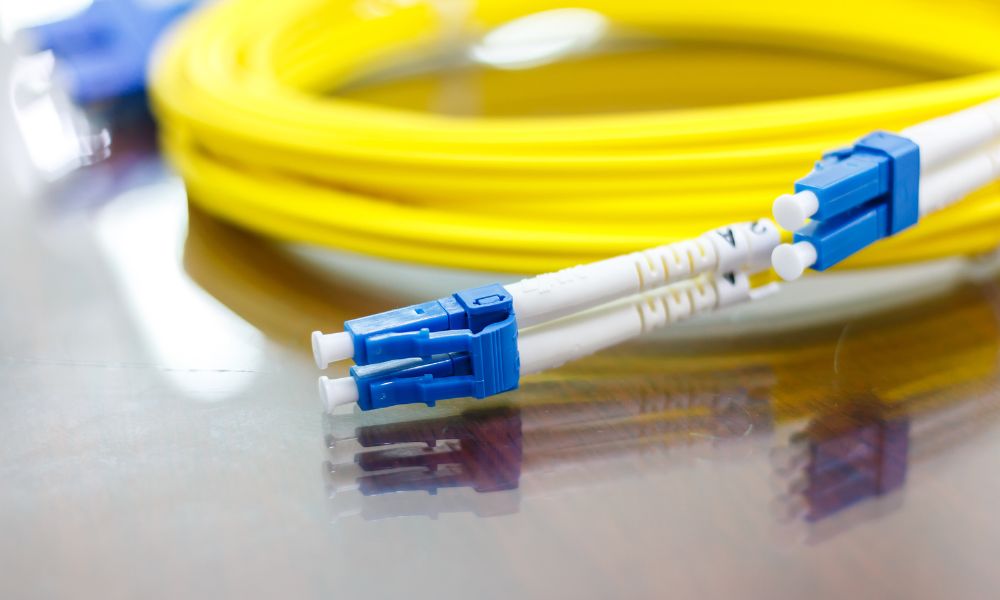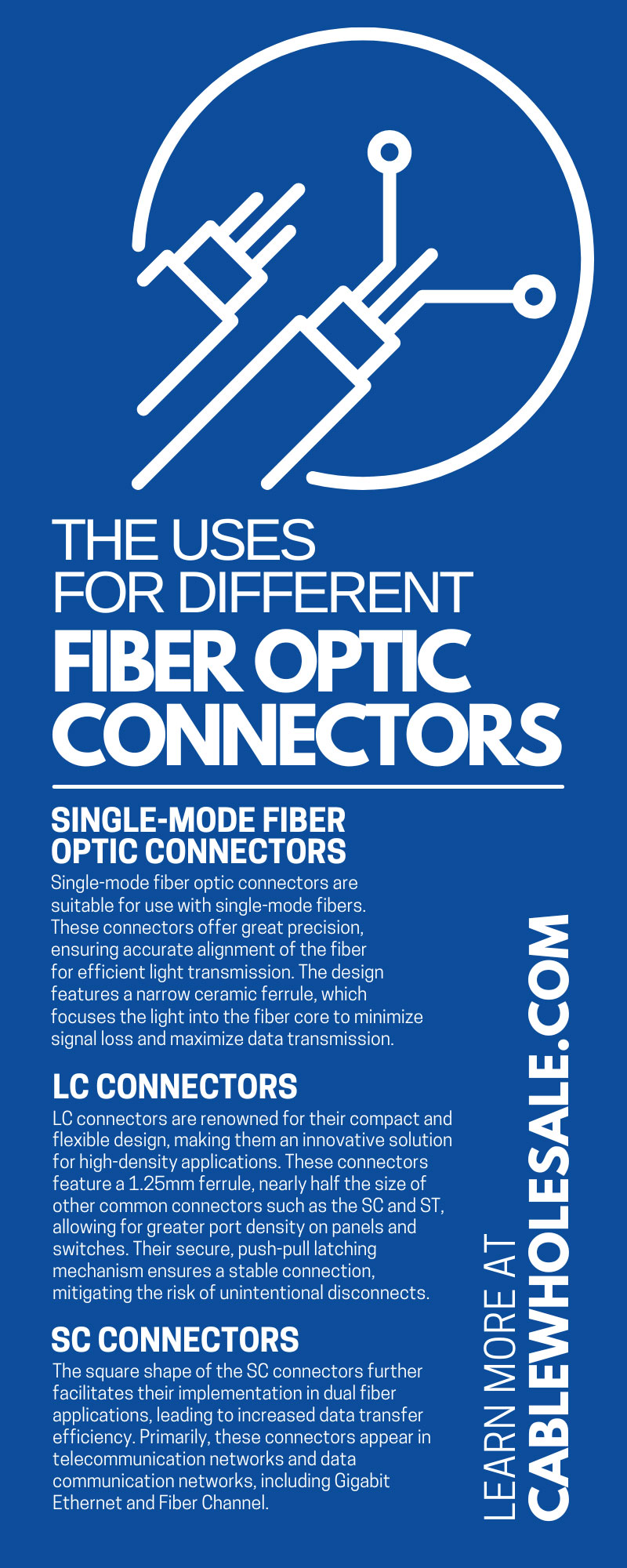
Understanding the Basics of Fiber Optics
Before we delve into the specifics of different types of fiber optic connectors, it’s important to understand the basics of fiber optics. Fiber optics, a technology that uses light to transmit information at high speeds, has revolutionized the world of telecommunications and data networking. This technology sends data over long distances through light pulses via a fiber optic cable.
These cables have thin strands of glass, known as optical fibers, that bundle together. The connectors at the ends of these cables play a critical role in ensuring that the connected devices accurately receive light pulses and correctly interpret the data.
Importance of Fiber Optic Connectors in Telecommunications
In the realm of telecommunications, fiber optic connectors play a pivotal role in maintaining a robust and high-speed data transmission infrastructure. These connectors ensure the accurate transmission and reception of light signals, guaranteeing the data’s integrity. Use different fiber optic connectors for different situations, each tailored to specific requirements and environmental conditions.
Different Types of Fiber Optic Connectors
Numerous fiber optic connectors are available, each with unique attributes and uses. Some of the most commonly used include SC (Standard Connector), ST (Straight Tip), FC (Ferrule Connector), MTP/MPO (Multi-fiber Termination Push-on/Pull-off), and LC (Lucent Connector). These connectors are typically compatible with single mode or multimode fibers, providing more options for how someone may set up their network using fiber optic Internet cables. Understanding the characteristics and applications of each connector type helps you select the optimal solution for your specific needs.
Single-Mode Fiber Optic Connectors
Single-mode fiber optic connectors are suitable for use with single-mode fibers. These connectors offer great precision, ensuring accurate alignment of the fiber for efficient light transmission. The design features a narrow ceramic ferrule, which focuses the light into the fiber core to minimize signal loss and maximize data transmission.
Popular in long-distance data transmission scenarios, including cable television networks, telephone systems, and college or corporate campuses, these connectors offer high bandwidth capacity and low signal loss, ensuring unparalleled performance. Their ability to transmit data over considerably larger distances makes them an excellent choice for applications that require robust, uninterrupted, high-speed data transfer.
Examination of Multimode Fiber Optic Connectors
Multimode fiber optic connectors accommodate multimode fibers, offering a broader light path that allows multiple modes of light to pass through simultaneously. While limiting the distance the light may travel, this characteristic significantly improves the amount of data transmitted at any given moment.
The connectors have slightly larger ferrules to support the multimode fibers, ensuring efficient coupling of the light source into the fiber. Multimode fiber optic connectors are indispensable for ensuring robust, high-speed data transmission within more compact networking environments. These connectors are popular solutions in applications requiring high data rates over short distances, such as within data centers and local area networks (LANs). They grant network engineers the flexibility and capacity to handle considerable data traffic, making them a preferred choice for applications where short-range data transmission demands are high.
LC Connectors
LC connectors are renowned for their compact and flexible design, making them an innovative solution for high-density applications. These connectors feature a 1.25mm ferrule, nearly half the size of other common connectors such as the SC and ST, allowing for greater port density on panels and switches. Their secure, push-pull latching mechanism ensures a stable connection, mitigating the risk of unintentional disconnects.
Angled physical contact (APC) LC connectors reduce back reflection due to their polish at an 8-degree angle, significantly enhancing their performance by reducing signal loss. Due to their design and features, LC connectors are the connector of choice in single-mode systems. They have extensive applications in data centers, telecommunications networks, and cable television services. Their use is also increasing in multimode systems due to their high precision and reliability.
SC Connectors
SC connectors are known for their ease of use, durability, and high application performance. They feature a push-pull coupling end face with a locking tab, which ensures a secure and steadfast connection, making this type of connector a reliable choice for many.
The square shape of the SC connectors further facilitates their implementation in dual fiber applications, leading to increased data transfer efficiency. Primarily, these connectors appear in telecommunication networks and data communication networks, including Gigabit Ethernet and Fiber Channel.
ST Connectors
ST connectors boast robustness and simplicity. They feature a bayonet-style design that ensures a simple and secure connection. These connectors’ cylindrical ceramic ferrules allow for precise fiber alignment to the connecting point, enabling efficient data transfer.
ST connectors are popular in networking hardware for their reliability and durability. Owing to their easy-to-use design and secure connection, ST connectors are common in industrial and military applications where a dependable connection is critical for sending and receiving messages. Their compatibility with single-mode and multimode fibers makes them a popular choice across various applications.
FC Connectors
FC connectors are notorious for their high precision and secure connection, making them especially suitable for high-vibration environments. These connectors feature a screw-on coupling mechanism and a position-locatable notch, ensuring a stable and accurate connection that isn’t prone to misalignment or inadvertent disconnections.
Primarily used with single-mode fibers, many networks use FC connectors for telecommunications, instrumentation, and high-speed data links due to their robust design and reliable performance. Their impressive durability under physical strain and ability to maintain the integrity of the signal makes them an excellent choice for applications where security and reliability are of utmost importance.
MTP/MPO Connectors
MTP/MPO connectors represent a significant leap in fiber optic connector technology. Their design houses multiple fibers in a single connector; these connectors are particularly suited for high-density applications requiring efficient space and rapid deployment.
Most MTP/MPO connectors typically hold up to 24 fibers but may hold more up to hold up to 72 fibers to connect fiber patch panels. Notably, these connectors are common in data centers, telecommunications, and high-speed enterprise networks, making them an essential part of the evolving landscape of multi-fiber technology.
Understanding the unique features and applications of various fiber optic connectors is pivotal to optimizing your telecommunications and data networking systems. Each connector, from the compact LC to the multi-fiber MTP/MPO, offers distinctive advantages tailored to specific environments and requirements. Leverage this knowledge to enhance the efficiency, reliability, and overall performance of your network infrastructure significantly, driving success in our increasingly connected world.




